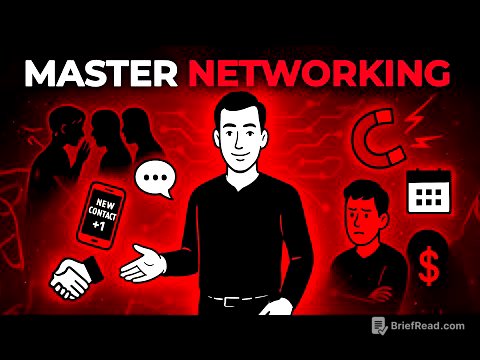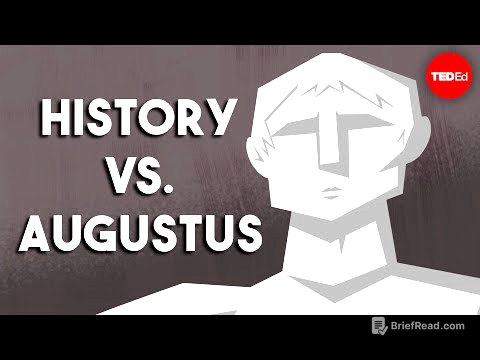TLDR;
This video explains how to achieve more by working less through the strategic use of leverage. It challenges the conventional view of productivity as simply doing more, defining it instead as maximizing output value per unit of input. The video introduces the concept of the "output dip," the resistance our brains have to activities that don't yield immediate results, and provides strategies to overcome this resistance. It also presents the "leverage trifecta," focusing on proficiency, process, and people to identify and fix productivity gaps. Finally, it discusses the "leverage sprint," an intense period dedicated to building leverage, and how this can lead to increased flow states and overall productivity.
- Productivity is about maximizing output value per unit of input, not just doing more.
- Overcoming the "output dip" is crucial for gaining leverage.
- The "leverage trifecta" (proficiency, process, and people) helps identify and fix productivity gaps.
- A "leverage sprint" can significantly boost productivity by focusing on building leverage.
- Increased leverage leads to more frequent flow states and higher overall productivity.
Introduction to Leverage and Productivity [0:00]
The video starts by illustrating the concept of achieving 30 hours of work in just one hour through understanding the science of productivity. It challenges the common misconception that productivity is about doing more, clarifying that it's actually about the ratio between input and output. Productivity is defined as input cost relative to output value, meaning that improving productivity involves achieving the same or better results with less time, energy, or attention. The video emphasizes that leverage is the key to increasing output without increasing input, or achieving the same output with less input.
Overcoming Biological Resistance to Leverage [1:26]
The video addresses the biological resistance to gaining leverage, comparing it to the scenario of chopping firewood with a dull axe. Sharpening the axe represents the temporary pause needed to gain leverage, which can be frustrating when immediate results are desired. This temporary pause is referred to as the "output dip," which occurs when setting up a system or training someone new. The brain tends to resist this dip, preferring familiar tasks that provide immediate gratification. To overcome this resistance, the video suggests cultivating a "leverage lens," which involves viewing work differently and tolerating the output dip.
Cultivating a Leverage Lens [3:12]
To gain leverage, one must learn to view work fundamentally differently. The video illustrates this with the example of two video editors with the same skills and salary, but vastly different outcomes due to their approach to work. One editor, Johnny, constantly sought ways to improve efficiency and build systems, while the other stuck to outdated workflows. Johnny's "leverage lens" allowed him to master project management, automate processes, and build a high-output editing team, leading to significant career advancement. The video contrasts this with a manager who mindlessly repeats tasks versus one who identifies patterns and creates solutions, such as a short email template to save time.
The Leverage Trifecta: Proficiency, Process, and People [6:00]
The video introduces the "leverage trifecta," which consists of proficiency, process, and people. Proficiency involves learning the right skills to maximize output. Process involves turning one-off tasks into repeatable systems and processes. People leverage involves multiplying oneself through others. By mastering these three areas, individuals can transform small inputs into massive outputs.
Proficiency Leverage: Mastering the Right Skills [6:45]
Proficiency leverage focuses on learning the right skills, not all skills. The key is to identify the skill that, if mastered, would make work easier or unnecessary. To determine this skill, one should identify their biggest constraint and the skill gap blocking them from achieving their desired results. The video introduces the "five for four proficiency leverage protocol," which involves dedicating five hours per week for four weeks to building that skill.
Process Leverage: Creating Repeatable Systems [8:09]
Process leverage involves turning one-off tasks into repeatable systems. The video illustrates this with the example of an artist who spends excessive time on inventory management, which could be streamlined with a basic inventory system. A high-leverage entrepreneur builds systems like pre-written email sequences and automated onboarding processes to free up time for more impactful work. To improve process leverage, one should identify tasks done at least twice, define the purpose, detail every step, automate where possible, and eliminate unnecessary steps.
People Leverage: Multiplying Through Others [10:18]
People leverage involves multiplying oneself through others. The video shares the story of Robert Caro, who was struggling to finish his book until Robert Gottlieb stepped in to provide funding and editorial support. Building people leverage means finding individuals who can transform challenges into trivial ones, such as a chief sales officer or an industry mentor. People leverage works because individual bandwidth is limited, and the right person can accelerate progress significantly.
The Leverage Sprint: Operationalizing Leverage [12:21]
The video introduces the "leverage sprint," a short, intense period focused on gaining leverage. This involves pausing non-essential tasks and working longer and harder to set up systems, automations, and processes. The leverage sprint is compared to pushing a car out of gas, requiring significant effort upfront but less effort to maintain once it's moving. To conduct a leverage sprint, one should block off one to four weeks, increase working hours by 30 to 50%, and dedicate at least 70% of that time to building leverage.
The Impact of Leverage on Flow States [13:36]
Gaining leverage fundamentally shifts the brain's reward system, making flow states more accessible and frequent. Flow states increase productivity, creativity, and learning speed. As leverage increases, so does flow proneness, which is the tendency to experience flow states more easily. Leverage shortens the struggle phase that precedes flow, making it easier to initiate and sustain focus. Top performers spend more time in flow because their leverage creates a self-reinforcing loop.
Conclusion: Time vs. Leverage [15:08]
The video concludes by illustrating the impact of leverage on career trajectory, comparing it to building a machine that multiplies output over time. By systematically levering up, individuals can transform time into an asset instead of a constraint. The video emphasizes that time is finite, but leverage is infinite, and gaining leverage can lead to limitless accomplishments.









